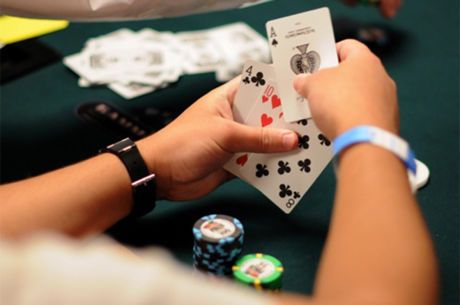How to Crush Three-Bet Pots in Pot Limit Omaha

Table Of Contents
- Learn More from Beasts of Poker
- Look for profitable spots to lead out after check-calling on dynamic boards
- Go for a smaller sizing in position when heavily blocking villain’s calling range
- Expert advice on c-betting strategy from a PLO crusher
- Board texture
- Using the right sizings in three-bet pots
- The actual hand, playability, and blockers
- Position is Key
- Final Words
If you prefer to get dealt four or five hole cards instead of two, this article is for you. Beasts of Poker Team Pro 'Arvain' is a long-time mid to high stakes PLO regular and is a huge ambassador of the great game of Pot-Limit Omaha, as Joey Ingram calls it.
The game is characterized by monster draws, plenty of action and big gaps between skill levels of players. As many grinders are learning GTO play through poker solvers, it’s best to keep ahead of the player population by putting in some time in the 'poker lab' yourself too!
One of the spots that can be challenging for many PLO players comes up when you play a three-bet pot. Whether you’re out of position or in position, maximizing your EV with the right betting line is important to your win rate since the pot is already quite big.
But, the right play is not always apparent.
Learn More from Beasts of Poker
Beasts of Poker gives you concrete examples of in-game situations, tips to use software to your advantage and analysis of different strategies that you can implement to your game
We asked high-stakes PLO players what are the most important concepts you need to master to do well in three-bet pots.
Here’s what they came up with:
Look for profitable spots to lead out after check-calling on dynamic boards
Dynamic boards give you a great opportunity to call with the plan of being more aggressive on future streets, especially after three-betting from the SB or the BB against a late position opener.
Let’s say that you are in a situation where the button opens and you have a hand you want to three-bet from the SB. The button calls your three-bet and the flop comes 10♥8♥4♠. While this is a board we want to check-call part of the time, you should plan what to do on different turn cards.
If a brick like 3♣ or 2♣ falls on the turn, as the three-bettor, you should lead out with a pot-sized bet with many hands in your range like big flush draws, an overpair with a gutshot or a combo draw.
Another example would be when you’ve three-bet a hand like K♥J♣J♠10♠ from the small blind against the cutoff 120BB’s deep and the flop comes Q♦J♦7♠. Sometimes, we should go for a check-call with a dynamic board like this where the nuts is changing a lot on the turn and/or the river. If the villain checks back and a blank turns lands, we can use a big sizing to deny equity from the multiple draws available on this board.
Many of your opponents will have a hard time to put you on a hand when you take this line unless they’re familiar with solver-approved plays like this. If you always bet your sets and combo draws on this type of flops out of position after three-betting, good regulars will have an easy time on pounding against your checks with most of the turn and river runouts – check-calling some of those will help you with board coverage for future streets.
Go for a smaller sizing in position when heavily blocking villain’s calling range
As a rule of thumb, most PLO players tend to use somewhat big sizings on wet flops in three-bet pots. In spots where you have the ultimate blockers(to most hands that villain could call the flop with) you can downsize as the player in position though. Future streets will not be that hard to navigate when you have position and the SPR (stack-to-pot ration) is low.
Take the following example:
Villain opens pot from middle position and Hero three-bets pot with TT66ss. Villain calls and checks to Hero on the flop of 6♥5♣3♥. In this spot, we can safely go for a sizing as low as 40% of the pot, as we’re not concerned about middle position having too many combos of 74xx or 42xx. We also block any 6x that villain could peel with.
SPR = stack-to-pot ratio relates the effective (smallest) stack size in play to the size of the pot to help determine your risk in a hand. Find out more by clicking here
Expert advice on c-betting strategy from a PLO crusher
When you make a c-bet in a three-bet pot, the pot is already pretty big and you are facing a big decision. Pretty often, you have to decide whether you want to play for stacks or not. When thinking about your c-bet strategy in three-bet pots, there are a few important factors to keep in mind:
Board texture
Some boards are favoring the threebettor and you can c-bet widely, and some boards are favoring the caller. For example, on a favoring flop like AA7r you can c-bet pretty much your entire range. On the other hand, when the flop reads 754 you shouldn’t c-bet anything, but go for a check with your whole range instead.
Using the right sizings in three-bet pots
Many good players are using just two different sizings in order not to make their strategy too complicated. The sizings they usually go for are either a small 1/3-1/2 bet or a large one close to pot or a pot-sized bet. The strategy is pretty simple on some flops and rather complicated on a bunch of flops.
On a paired high card board like AA7, roughly all the hands are c-bets and only the small sizing is used. However, on a dynamic board like QJ7ss, 30-40% of hands are checked and when it comes to choosing a c-bet sizing, some hands play well with the small bet and some hands play better with a committing pot-sized bet.
The actual hand, playability, and blockers
So, which hands should you check and which ones should you c-bet in three-bet pots?
PLO is played with 4 (or 5) cards so a good rule is to actually use all of them. Not all Aces or top sets are the same. Many times your decision of whether to c-bet some specific hands in the same category depends on your side cards. For example, dry Aces with a gutter and a backdoor flush draw often makes a better c-bet than Aces with not so many good turns to continue betting.
Also, blocking other key cards on the board is super relevant. K♠Q♣J♥9♥ is a clear check on a flop like Q♣Q♥10♥ because your hand blocks the opponent’s calling range so heavily. A hand like KQ76ss with no hearts falls clearly in the c-betting category on the same flop.
Position is Key
Having position is very beneficial in three-bet pots and therefore you can three-bet lighter in position. The main reason is you can get away with speculative holdings more easily in position. In position, you have the option to check back & get a free turn with hands that have some potential but are not good enough to play for stacks. You can also ensure at least one bet goes into the pot on each street if the situation requires you to do so.
Final Words
Three-betting with the rights hands in PLO is something almost all regulars know better than their own pockets, but playing postflop is the tricky part. You should plan what do to on different turns and rivers and adjust your bet sizings based on the board types.
If you make regular mistakes in three-bet pots without even realizing it, your win rate will suffer greatly. Three-bet pots are an important area of the game to master in PLO, as taking the right betting lines can help you win more than your fair share of the larger-than-average pots.
In the end, mastering three-bet pots will take both dedicated study outside the tables and a ton of experience playing. Good luck!
Become a beast in poker today with . Join the forum, gain insight from Beasts Of Poker ambassadors and learn to crush the game!









